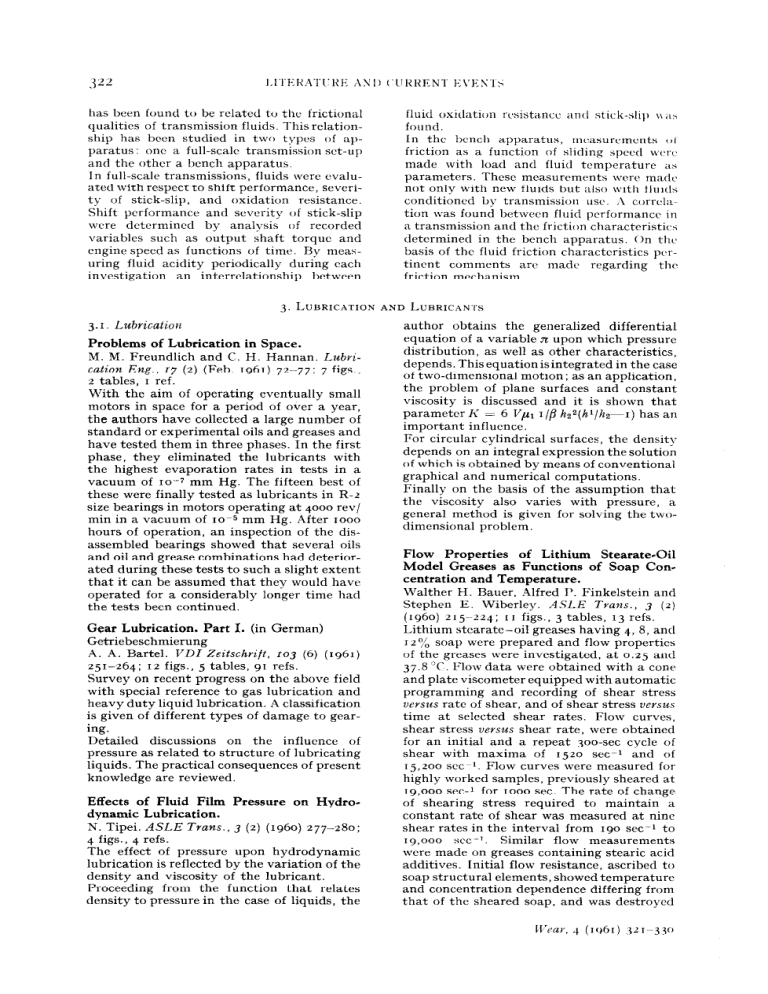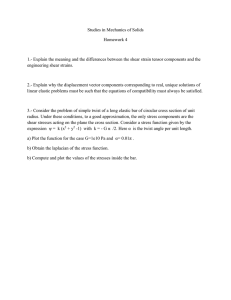Lubrication Research: Transmission Fluids, Space, and Grease Properties
advertisement

has been found to be related to the frictional qualities of transmission fluids. This relationship has been studied in two types of alipar&us : one a full-scale transmission set-up and the other a bench apparatus. In full-scale transmissions, fluids were evaluated with respect to shift performance, severity of stick-slip, and oxidation resistance. Shift performance and severity of stick-slip were dctcrmincd by analysis of recorded variables such as output shaft torque and engine speed as functions of time. Hy measuring fluid acidity periodically during each investigation an interrelationship between fluid oxidation r-esistance an(l stick-slip \\A‘found. In the bench apparatus, m(asurcments OI friction as a function of sliding slxxd wcr( made with load and fluid temperature as parameters. These measurements were made not only with new fluids but also with fluids conditioned by transmission use. .\ corrcl;ttion was found between fluid pcrformancc in a transmission and the friction characteristics determined in the bench apparatus. On the basis of the fluid friction characteristics lx~i-tinent comments arc made regarding the friction mechanism. 3.1. Lubricatiou author obtains the generalized differential equation of a variable ?I upon which pressure distribution, as well as other characteristics, depends. This equationisintegrated in the case of two-dimensional motion ; as an application, the problem of plane surfaces and constant viscosity is discussed and it is shown that parameter K = 6 VP, I//? h22(hi/hzPr) has an important influence. For circular cylindrical surfaces, the density depends on an integral expression the solution of which is obtained by means of conventional graphical and numerical computations. Finally on the basis of the assumption that the viscosity also varies with pressure, a general method is given for solving the twodimensional problem. Problems of Lubrication M. M. Freundlich cation Eng., in Space. and C. H. Hannan. Lubvi1961) 72-77; 7 figs., 17 (2) (Feb. z tables, I ref. With the aim of operating eventually small motors in space for a period of over a year, the authors have collected a large number of standard or experimental oils and greases and have tested them in three phases. In the first phase, they eliminated the lubricants with the highest evaporation rates in tests in a vacuum of IO.-~ mm Hg. The fifteen best of these were finally tested as lubricants in R-r size bearings in motors operating at 4000 rev/ min in a vacuum of 10-s mm Hg. After IOOO hours of operation, an inspection of the disassembled bearings showed that several oils and oil and grease combinations had deteriorated during these tests to such a slight extent that it can be assumed that they would have operated for a considerably longer time had the tests been continued. Gear Lubrication. Part I. (in German) Getriebeschmierung A. A. Bartel. VDI Zeitschvift, 103 (6) (1961) 251-264; 12 figs., 5 tables, 91 refs. Survey on recent progress on the above field with special reference to gas lubrication and heavy duty liquid lubrication. A classification is given of different types of damage to gearing. Detailed discussions on the influence of pressure as related to structure of lubricating liquids. The practical consequences of present knowledge are reviewed. Effects of Fluid Film dynamic Lubrication. N. Tipei. ASLE Trans., 4 figs., 4 refs. Pressure on Hydro- 3 (2) (1960) 277-280: The effect of pressure upon hydrodynamic lubrication is reflected by the variation of the density and viscosity of the lubricant. Proceeding from the function that relates density to pressure in the case of liquids, the Flow Properties of Lithium Stearate-Oil Model Greases as Functions of Soap Concentration and Temperature. Walther H. Rauer, .4lfred I’. Finkelstein and Stephen E. Wiberley. ASLE Trans., 3 (r) (1960) 2r5mm~24; II figs., 3 tables, 13 refs. Lithium stcaratc-oil greases having 4. 8, and I LT/, soap were prepared and flow properties of the greases were investigated, at 0.25 and 37.8 ‘C. Flow data were obtained with a cone and plate viscometer equipped with automatic programming and recording of shear stress UL’YSUS rate of shear, and of shear stress z)wsus time at selected shear rates. Flow curves, shear stress Z~~YSUS shear rate, were obtained for an initial and a repeat 3oo-set cycle of shear with maxima of 1520 set-i and of r5,zoo SK 1. Flow curves were measured fothighly worked samples, previously sheared at 19,000 set-* for IOOOsec. The rate of change of shearing stress required to maintain a constant rate of shear was measured at nine shear rates in the interval from 190 set-i to 19,000 see-*. Similar flow measurements were made on greases containing stearic acid additives. Initial flow resistance, ascribed to soap structural elements, showed temperature and concentration dependence differing from that of the sheared soap, and was destroyed



